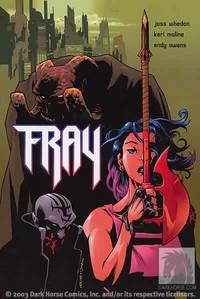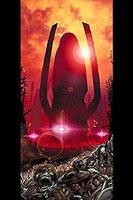 Fray
Fraywriter: Joss Whedon
artists: Karl Moline and Andy Owens
Dark Horse Comics, November 2003
Few franchises have been created over the last two decades that rival the popularity of the TV shows Buffy the Vampire Slayer and Angel. Many of the characters have crossed over into the realm of comics, sharing other adventures not seen on the small screen. Judging from the Buffyverse comics I've gotten my hands on that came out while the shows were on the air, most of those stories were put out there for nothing more than the almighty dollar. I'm sure some of the hardest of hardcore fans love these comics -- after all, if you were craving a couple of new Spike retorts in the middle of July 2001, these would have held you over until the real thing hit in the fall -- but they're weak at best, usually written by people who have watched the show as opposed to having sat on set or in the writer's room.
Since the shows have ended, new comics from IDW focusing on Spike and Angel have surfaced, and while they are improvements over the Dark Horse issues I've read, they are still not quite up to the standard I'd come accustomed to as a fan.
That is until I came across Fray.
Fray is different than all other Buffyverse comics for one reason -- it was scripted by Joss Whedon, the mastermind of all things slayer. Unlike the other comic adaptations, Whedon's book has not only the distinctive tone that allows me to immerse myself in that universe so completely, but also a story that feels fresh, not merely a rehash of other ideas already expressed on television.
Fray is the story of a slayer from the future, a future far from the Sunnydale we'd become so familiar with. Fray lives in an urban slum populated by an array of humans, mutants, fish-creatures, and of course vampires -- only they're no longer known as vampires, but rather as "lurks" because they've been obsolete for so many generations. Whedon's play with language in Fray is actually a very natural progression to the setting of the book. It's one of the main aspects which separate it from the TV show.
Another major departure from the show is that Fray doesn't even realize she is the slayer. She just knows she has certain super powers and those powers allow her to live on the wrong side of the law, stealing specific objects to sell on the black market. In fact, no one knows what a slayer is -- save for Urkonn, a demon sent to instruct her on the ancient ways of the slayer in order to save her world from the inevitable doom that waits. In other words, he's her Watcher. Fray's also got a past that would make Faith's life seem sheltered, especially in her relationships with her brother and sister (I won't spoil those in this review, but they're a couple of doozies).
In addition to the riveting, action-packed script, there is some really fine artwork. I'm not familiar with Karl Moline, but he is definitely a talented man. His monsters are creepy when they need to be, the movement between panels is fluid, and his futuristic backgrounds are reminiscent enough of our own world to not seem completely foreign. But his most favorable attribute as an artist is how he approached Fray. She is very far from the typical big breasted, toothpick waistline that is an epidemic amongst comic book artists. Moline draws Fray as if she were a real girl. Sure, she would be beautiful if she was an actual woman, but it's captured in a natural, athletic form of beauty. Plus, Fray may be a slayer, but I was never imagining Buffy, Faith, or even Kendra as she jumped, kicked, and staked her way through the book. Of course, a lot of that was due to Whedon's characterization of her, but Moline's talent is undeniable.
As much as I enjoyed the majority of this story, it is not without its flaws. The mutant humans seem a bit unnecessary as they're not developed enough to warrant inclusion in the book. Also, a few of the standard Whedon twists occurred too quickly and without enough explanation, particularly concerning one of the major characters at the end of the story. But these are minor gripes and I suspect Whedon had to cut scenes in order to fit the meat of Fray into the original run of eight issues.
Now, I've used a ton of names and terms that are common knowledge amongst fans of the Buffyverse, but this book is not only for those people. Joss clearly wrote this for anyone to pick up and have an enjoyable read. So have no worries if you're unfamiliar with all things slayer related; you'll be able to grasp everything of importance. Pick this one up regardless if you're a fan or not. It's unlikely you'll be disappointed.
9 out of 10
*** Now that LBM has expanded beyond comics, I've retooled some of the columns for the sake of simplicity. This was originally part of a feature I did called "Graphic Novel Grab Bag." I only ever wrote five, so I've re-tagged them as Longbox entries. Enjoy the early days of LBM that I've somehow resisted the urge to purge. -- JA, 1/20/10 ***





